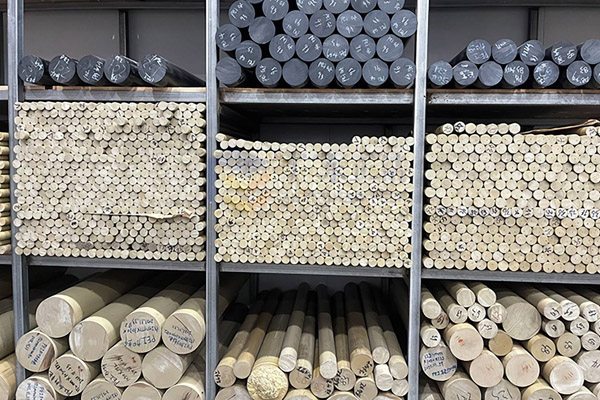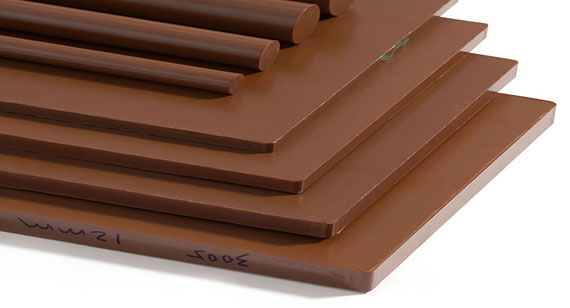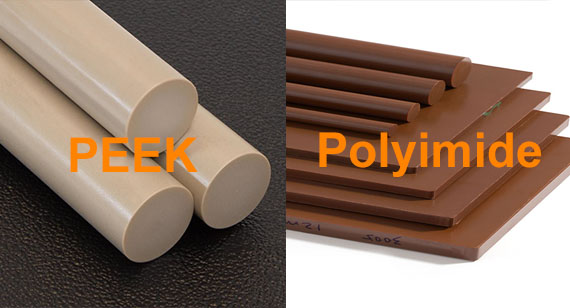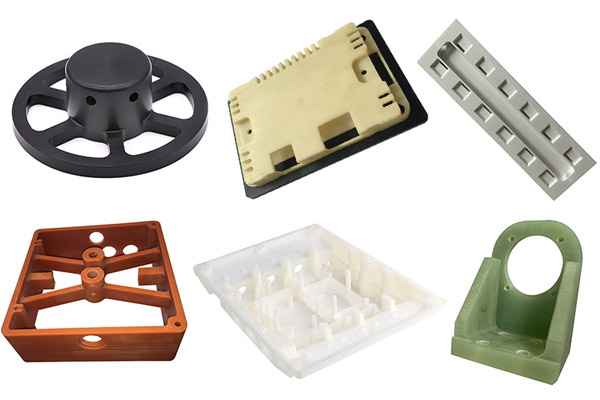15 years one-stop China custom CNC machining parts factory
 652 |
Published by VMT at Sep 20 2023
652 |
Published by VMT at Sep 20 2023
What is Peek?
PEEK stands for Polyetheretherketone, which is a high-performance thermoplastic polymer. PEEK is known for its exceptional mechanical properties, chemical resistance, and high-temperature stability, making it a popular choice in various industries.

Advantages and Disadvantages of PEEK (Polyetheretherketone)
Advantages:
High-Temperature Stability: PEEK can operate reliably at elevated temperatures, demonstrating exceptional heat resistance, making it suitable for high-temperature applications.
Chemical Resistance: PEEK exhibits outstanding resistance to a wide range of chemicals, including acids, bases, solvents, and oils, making it valuable in the chemical and oil and gas industries.
Mechanical Performance: PEEK offers remarkable mechanical properties, including high tensile strength, stiffness, and toughness, making it suitable for applications requiring high load-bearing capabilities.
Electrical Insulation: PEEK serves as an excellent electrical insulator, finding application in electronic components and electrical systems.
Biocompatibility: PEEK is biocompatible, making it suitable for use in medical devices and implants.
Low Flammability: PEEK exhibits low flammability and emits minimal smoke when exposed to fire, a critical safety feature in certain applications.
Dimensional Stability: PEEK maintains its dimensional stability even under challenging conditions, making it suitable for precision engineering and aerospace applications.
Ease of Machining: PEEK is relatively easy to machine, simplifying the manufacturing process for components and parts.
Disadvantages:
High Cost: PEEK is relatively expensive, which can limit its widespread use in cost-sensitive applications.
Hygroscopicity: PEEK has some degree of water absorption, which may impact its performance when exposed to moist environments.
Complex machining: While PEEK is relatively easy to machine, specific machining processes and tools may be required, necessitating specialized knowledge and equipment.
Thermal Expansion: PEEK has a relatively high linear coefficient of thermal expansion, which needs consideration in designs involving temperature changes and dimensional stability.
Limited Dyeability: PEEK's dyeability is limited, which can restrict its use in applications requiring specific colors.
While PEEK possesses many outstanding characteristics, a careful balance of its advantages and disadvantages should be considered when selecting it for specific application requirements.
What is Polyimide?
Polyimide, often abbreviated as PI, is a high-performance polymer known for its exceptional thermal stability, mechanical properties, and chemical resistance. Polyimides are a class of synthetic polymers that exhibit remarkable heat resistance, making them valuable in a wide range of high-temperature applications.

Advantages and Disadvantages of Polyimides (PI)
Advantages:
Exceptional High-Temperature Performance: Polyimides exhibit outstanding thermal stability and can endure extremely high temperatures, making them suitable for applications in extreme heat environments.
Chemical Resistance: Polyimides possess remarkable resistance to various chemicals, including acids, bases, and solvents, enhancing their durability in corrosive surroundings.
Mechanical Robustness: Polyimides demonstrate excellent mechanical properties, such as high tensile strength and toughness, ensuring their resilience to mechanical stress and load-bearing requirements.
Electrical Insulation: Polyimides serve as excellent electrical insulators, making them essential for electrical and electronic components, where electrical integrity is critical.
Dimensional Stability: These polymers maintain their shape and dimensions even when exposed to temperature fluctuations due to their low coefficient of thermal expansion.
Low Outgassing: In vacuum and space applications, polyimides are preferred for their minimal outgassing, reducing the risk of contamination in sensitive environments.
Radiation Resistance: Polyimides exhibit resistance to ionizing radiation, making them valuable in nuclear and space-related applications.
Disadvantages:
High Cost: Polyimides are relatively expensive to produce, limiting their use in cost-sensitive applications.
machining Complexity: The machining of polyimides can be complex, requiring specialized knowledge and equipment, which can add to manufacturing costs.
Brittleness at Low Temperatures: While polyimides excel at high temperatures, they can become brittle at very low temperatures, impacting their suitability for cryogenic applications.
Limited Color Options: Polyimides are typically amber or brown in color, limiting their suitability for applications requiring specific colors.
Solubility Challenges: Polyimides are not readily soluble in common solvents, which can pose challenges during machining and recycling.
Long Cure Times: The curing process for polyimides can be time-consuming, potentially affecting production efficiency.
Polyimides are favored for their unique combination of properties, but their advantages and disadvantages should be carefully considered when selecting them for specific applications.
Differences Between PEEK and Polyimides: A Detailed Comparison

1. Chemical Structure:
PEEK (Polyetheretherketone): PEEK is a semi-crystalline thermoplastic known for its linear aromatic polymer structure, containing repeating units of ether and ketone groups. It belongs to the polyaryletherketone family.
Polyimides: Polyimides are a class of synthetic polymers characterized by their imide functional groups, which form a highly cross-linked, three-dimensional structure. Polyimides are known for their diverse chemical structures, including aliphatic and aromatic variants.
2. Temperature Resistance:
PEEK: PEEK offers excellent high-temperature resistance, with a continuous use temperature of up to 250°C (482°F).
Polyimides: Polyimides are renowned for their exceptional thermal stability and can withstand continuous temperatures well above 300°C (572°F).
3. Mechanical Properties:
PEEK: PEEK exhibits high tensile strength, stiffness, and toughness, making it suitable for load-bearing applications.
Polyimides: Polyimides also possess excellent mechanical properties, including high tensile strength, but specific properties can vary based on the particular polyimide.
4. Chemical Resistance:
PEEK: PEEK is resistant to a wide range of chemicals, including many acids, bases, and organic solvents.
Polyimides: Polyimides are known for their exceptional chemical resistance and can withstand exposure to harsh acids, bases, and solvents.
5. Electrical Insulation:
PEEK: PEEK is a good electrical insulator but not as widely used in electrical applications as polyimides.
Polyimides: Polyimides excel as electrical insulators and are commonly employed in electronic components.
6. Color Options:
PEEK: PEEK is typically available in natural beige or black colors.
Polyimides: Polyimides can come in various colors, offering more flexibility for applications requiring specific aesthetics.
7. machining Methods:
PEEK: PEEK can be processed using standard thermoplastic techniques, such as injection molding and extrusion.
Polyimides: machining polyimides can be more complex, often requiring specialized techniques and equipment.
8. Cost:
PEEK: PEEK is relatively expensive compared to many other engineering plastics.
Polyimides: The cost of polyimides can vary depending on the specific type and grade but is generally competitive in high-performance applications.
9. Applications:
PEEK: Common applications for PEEK include aerospace components, automotive parts, medical devices, and industrial components.
Polyimides: Polyimides find use in aerospace, electronics, automotive, and military applications, as well as in specialized fields like microelectronics and space exploration.
Both PEEK and polyimides offer unique properties, and the choice between them depends on specific application requirements and conditions.
PEEK vs. Polyimides: Which is Right for You?
Choosing between PEEK (Polyetheretherketone) and Polyimides depends on your specific application needs and performance requirements. Both materials offer distinct advantages, and the decision should be based on factors like temperature resistance, mechanical properties, chemical resistance, and machining considerations. Here's a guide to help you determine which material is most suitable for your needs:
Choose PEEK (Polyetheretherketone) if:
High-Temperature Performance: PEEK excels in high-temperature environments, with a continuous use temperature of up to 250°C (482°F). It's an excellent choice for applications that require heat resistance without the extreme temperatures that polyimides can handle.
Ease of machining: PEEK can be processed using standard thermoplastic techniques like injection molding and extrusion, which may be more accessible for your manufacturing process.
Mechanical Strength: If your application requires high tensile strength, stiffness, and toughness, PEEK is a strong contender.
Availability in Natural Colors: PEEK is typically available in natural beige or black colors, which can be suitable for many applications without specific color requirements.
Choose Polyimides if:
Extreme High-Temperature Requirements: Polyimides are renowned for their exceptional thermal stability, making them ideal for applications in extreme heat, where temperatures can exceed 300°C (572°F).
Diverse Chemical Resistance: Polyimides offer superior resistance to a wide range of chemicals, including harsh acids, bases, and solvents. If your application involves exposure to aggressive chemicals, polyimides are a top choice.
Electrical Insulation: For electrical and electronic components where excellent electrical insulation properties are critical, polyimides are often preferred.
Color Customization: Polyimides come in various colors, providing more flexibility for applications with specific aesthetic requirements.
Specialized Applications: Polyimides are commonly used in aerospace, electronics, automotive, and military applications, as well as specialized fields like microelectronics and space exploration.
Radiation Resistance: If your application involves exposure to ionizing radiation, polyimides' resistance to radiation damage is advantageous.
Cost Considerations:
PEEK is generally more cost-effective than polyimides, which can be relatively expensive. Your budget may influence your choice, especially for larger-scale applications.
In conclusion, both PEEK and polyimides are outstanding materials with unique properties. Consider the specific demands of your application, including temperature, chemical exposure, and mechanical requirements, to determine which material aligns best with your project's needs.
Peek vs. Polyimide: Applications
PEEK (Polyetheretherketone) Applications:
Aerospace: PEEK is used in aerospace applications for components requiring high strength-to-weight ratios, such as aircraft interior parts, brackets, and connectors.
Medical Devices: PEEK's biocompatibility makes it suitable for medical implants, dental devices, and surgical instruments. It's also used in medical equipment housings.
Automotive: PEEK is employed in the automotive industry for various applications, including electrical connectors, seals, and bearings due to its resistance to chemicals and wear.
Oil and Gas: PEEK is utilized in oil and gas exploration for downhole tools, seals, and valve components due to its resistance to high temperatures and chemicals.
Electronics: PEEK's electrical insulation properties are valuable in electronic components like connectors, insulators, and circuit boards.
Industrial Components: PEEK is found in industrial machinery, pumps, and seals where its combination of mechanical strength and chemical resistance is beneficial.

Polyimides Applications:
Aerospace: Polyimides are extensively used in the aerospace industry for their exceptional heat resistance, making them suitable for aircraft engine components, thermal shielding, and spacecraft applications.
Electronics: Polyimides are employed in flexible printed circuits, insulating films, and microelectronics due to their electrical properties and dimensional stability.
Automotive: In the automotive sector, polyimides find applications in under-hood components, electrical connectors, and sensors requiring high-temperature resistance.
Medical Devices: Polyimides are used in medical equipment, such as catheters and sensors, where flexibility, biocompatibility, and chemical resistance are essential.
Microelectronics: Polyimides are a key material in the microelectronics industry for semiconductor packaging, flexible displays, and printed circuit boards.
Chemical machining: Polyimides are employed in chemical machining equipment, gaskets, and seals due to their resistance to harsh chemicals.
Space Exploration: Polyimides are used in space missions for their ability to withstand extreme conditions, making them suitable for spacecraft components and thermal insulation.
Military Applications: Polyimides are utilized in military equipment, including aircraft, missiles, and protective gear, where their performance under demanding conditions is crucial.
In summary, PEEK and polyimides have diverse applications across industries where their unique properties, such as high-temperature resistance, chemical resistance, and electrical insulation, are valued. The choice between the two materials depends on the specific requirements of each application.
Find a Reliable Partner to Make Your Choice
Do you know how to choose the right metal/plastic material for your project? Or, if you need expert help getting the most out of both materials, VMT can help.
We provide custom CNC machining services for Peek, Polyimide, PTFE, POM, Nylon, Acrylic, Steel, Aluminum, Titanium, Copper and other materials. Whether it is CNC prototyping or low-volume part production, our team of professional engineers can select the right metal/plastic material for you and meet your needs to a high standard. Then, just upload your CAD files to our email: inquiry@vimetal.com.cn to get a project quote.
Conclusion
In summary, PEEK (Polyetheretherketone) and polyimides are two versatile polymer materials with distinct properties and applications:
PEEK:
Suitable for high-temperature applications up to 250°C (482°F).
Resistant to chemicals, making it suitable for a range of industries, including medical, aerospace, and automotive.
Biocompatible and used for medical implants and devices.
Processed using standard thermoplastic techniques like injection molding and extrusion.
Typically available in natural beige or black colors.
Used in automotive components, electrical connectors, and more.
Polyimides:
Exceptional high-temperature resistance, enduring temperatures above 300°C (572°F).
Excellent chemical resistance, making them ideal for applications exposed to harsh chemicals.
Widely used in aerospace, electronics, and microelectronics industries.
Commonly employed in the military, space exploration, and flexible printed circuits.
Available in various colors for applications with specific aesthetic requirements.
Can be more complex to process and may require specialized techniques.
The choice between PEEK and polyimides depends on specific application requirements. PEEK is preferred for applications requiring high-temperature resistance up to 250°C, ease of machining, and availability in natural colors. Polyimides excel in extreme high-temperature environments, diverse chemical resistance, and specialized applications like aerospace and microelectronics. Consider the unique properties of each material when selecting the most suitable one for your project.
FAQs About Peek and Polyimide
Frequently Asked Questions (FAQs) About PEEK (Polyetheretherketone) and Polyimides:
1. What is PEEK used for?
PEEK is used in various industries, including aerospace, medical, automotive, and electronics, for applications such as medical implants, aircraft components, electrical connectors, and more.
2. Is PEEK biocompatible?
Yes, PEEK is biocompatible, making it suitable for medical implants and devices. It doesn't cause adverse reactions when in contact with the human body.
3. Can PEEK withstand high temperatures?
Yes, PEEK has a high-temperature resistance, with a continuous use temperature of up to 250°C (482°F). It remains stable in elevated temperature environments.
4. Is PEEK resistant to chemicals?
PEEK exhibits good resistance to a wide range of chemicals, including acids, bases, and organic solvents.
5. How is PEEK processed?
PEEK can be processed using standard thermoplastic techniques like injection molding and extrusion.
6. What are the color options for PEEK?
PEEK is typically available in natural beige or black colors.
7. Is PEEK an electrical insulator?
While PEEK is an electrical insulator, it may not be the primary choice for electrical applications, as other materials like polyimides are preferred.
8. What are common PEEK applications in the automotive industry?
PEEK is used in automotive applications like electrical connectors, seals, and bearings due to its resistance to chemicals and wear.
Frequently Asked Questions (FAQs) About Polyimides:
1. What are polyimides used for?
Polyimides are used in diverse industries, including aerospace, electronics, medical, and microelectronics, for applications such as aircraft components, microchips, and flexible printed circuits.
2. Can polyimides withstand extreme temperatures?
Yes, polyimides have exceptional thermal stability and can endure continuous temperatures well above 300°C (572°F).
3. Are polyimides resistant to chemicals?
Polyimides are known for their excellent chemical resistance and can withstand exposure to harsh acids, bases, and solvents.
4. Are polyimides good electrical insulators?
Yes, polyimides excel as electrical insulators and are commonly used in electronic components.
5. What color options are available for polyimides?
Polyimides come in various colors, providing flexibility for applications with specific aesthetic requirements.
6. Can polyimides be used in space exploration?
Yes, polyimides are used in space missions for their ability to withstand extreme conditions, making them suitable for spacecraft components and thermal insulation.
7. How are polyimides processed?
machining polyimides can be more complex and may require specialized techniques and equipment.
8. Are polyimides used in military applications?
Yes, polyimides are employed in military equipment, including aircraft, missiles, and protective gear, where their performance under demanding conditions is crucial.
These FAQs provide an overview of common questions related to PEEK and polyimides, highlighting their properties and applications in various industries.
